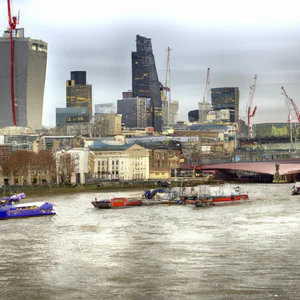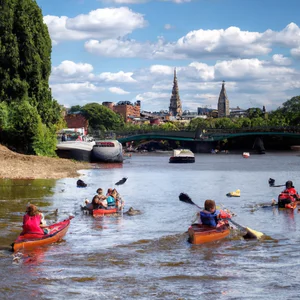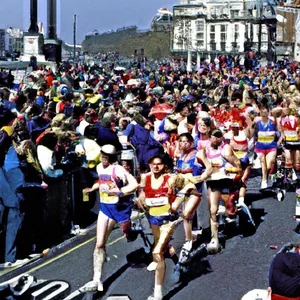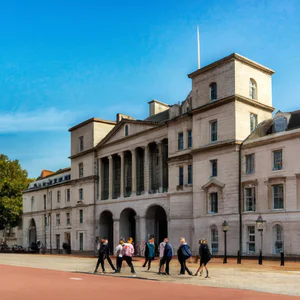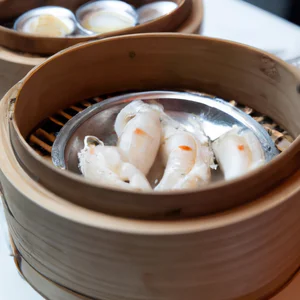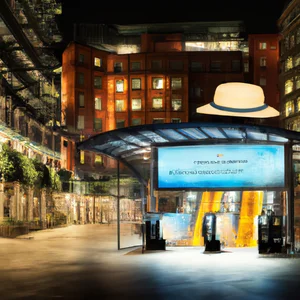Book your experience
Islington: trendy clubs, theaters and Georgian houses in north London
Islington, eh? It’s that place in North London where time seems to stand still for a moment, but in a good way, you know? There are places that make you want to stay there all day, perhaps sipping a coffee while reading a book or chatting with friends. And then, the theatres! Oh, let’s not even talk about it… there are shows for all tastes, from the more alternative ones to the slightly more mainstream ones.
What about Georgian houses? They are like beautiful ladies from times gone by who walk elegantly, with pastel colors that make you feel like you’re in a romantic film. In short, every corner has its own story to tell, and this is what drives me crazy about Islington.
I remember once, during a weekend, I decided to take a walk around this neighborhood with some friends. We got lost among the alleys and discovered a cute little place that served the best brunch in the area. I don’t know if I’m exaggerating, but those eggs benedict were amazing! And the fact that there was such a relaxed atmosphere, with people laughing and chatting, made everything even more special.
So, in all of this, I think that Islington is one of those places where you can really breathe a different, almost magical air, where every day is an opportunity to discover something new. Sure, maybe it’s not for everyone, but if you like art, culture and a pinch of eccentricity, well, you can’t miss it!
Discover Islington’s trendy venues
When I first set foot in Islington, I immediately felt surrounded by a vibrant and creative atmosphere, which seemed to pulsate in every corner. A particular memory takes me back to an evening spent at The Old Queen’s Head, a pub which, in addition to serving local craft beers, hosts live music evenings ranging from folk to alternative rock. While sipping a pint of craft beer, I attended a performance by an emerging artist, surrounded by a crowd of enthusiasts, all united by the same desire to discover new talents. This is just one of many examples of how Islington is not just a place to visit, but an experience to live.
The trendiest places
Islington is a real paradise for those who love trendy clubs. Among the best known, BrewDog Islington stands out, a temple of craft beer that offers a selection of over 20 beers on tap, many of which are produced in their Scottish factory. Also not to be missed is The Breakfast Club, a welcoming restaurant that serves innovative breakfasts until late, perfect for starting the day with energy.
For those looking for a more intimate atmosphere, I recommend The Narrowboat, a pub overlooking the Regent canal, where the outdoor tables offer a picturesque view, especially at sunset. Here, you can enjoy a delicious Sunday roast, a traditional British dish that never disappoints.
An insider tip
A tip that few people know is to visit Exmouth Market on weekdays. Although it is also popular on weekends, during the week it is a real treasure of small culinary and artisanal gems. You can find kiosks serving specialties from around the world, from Mexican food to ethnic Asian dishes, and every Wednesday there is a street food market that turns the street into a lively festival of flavours.
The cultural impact of Islington
Islington’s hip clubbing scene isn’t just a recent phenomenon; it is the result of a cultural legacy that has its roots in the 1980s and 1990s, when the area began to transform into a creative epicenter. Thanks to its location close to central London and its vibrant arts community, Islington has attracted artists, musicians and designers, resulting in a culture that celebrates diversity and innovation.
Sustainability and responsibility
When exploring Islington’s locales, it’s vital that you do so responsibly. Many bars and restaurants in the area are committed to sustainable practices, such as using local ingredients and reducing food waste. Try to choose venues that promote eco-friendly practices, helping to keep the area vibrant and sustainable.
Immersed in this atmosphere, you might be tempted to stay all evening. But don’t forget to plan a visit to one of the many historic theaters that dot the neighborhood, where art and culture intertwine in a way that makes Islington one of the most fascinating areas of London.
In conclusion, which place in Islington impressed you the most? Have you ever had an experience that transformed your perception of a neighborhood? The beauty of Islington lies in its ability to surprise and inspire.
Historic Theatres: Islington’s cultural scene
An unforgettable experience
I still remember the first time I walked through the doors of Sadler’s Wells Theatre. The scent of polished wood and the vibrant atmosphere surrounded me, as the buzz of the audience filled the air. It was an evening of contemporary dance, and every movement on stage seemed to tell a story that transcended words. Islington, with its rich theatrical tradition, offers cultural experiences that can’t be found anywhere else, and that’s just the beginning.
The beating heart of culture
Islington is a treasure trove of historic theaters spanning various artistic forms. In addition to the famous Sadler’s Wells, the Almeida Theatre is known for its innovative productions and its commitment to bringing contemporary works to ever-wider audiences. If you want to explore the best of British theatre, these spaces’ events program is updated regularly; you can find detailed information on their official websites and social media.
An insider tip
If you want a truly unique experience, consider attending one of the opening nights of a new show. These opportunities not only offer the chance to witness hot-off-the-press productions, but often also include Q&A sessions with the artists, allowing you to get to the heart of the creative process. A perfect way to connect with the Islington theater community!
Islington’s cultural heritage
Islington’s theater scene is rich in history and culture. During the 19th century, the neighborhood became a center for the performing arts, attracting talent from around the world. This tradition continues today, with a mix of classic and contemporary productions that reflect the diversity and creativity of the neighborhood. It’s not just an opportunity to be entertained, but also a way to understand the challenges and joys of London life.
Sustainability and theatre
Many Islington theaters have adopted sustainable practices, from the use of eco-friendly materials in productions to efforts to reduce waste. Before attending a show, check to see if the theater offers responsible travel options, such as promoting public transportation or renting bikes nearby.
Soak up the atmosphere
Imagine walking along the streets of Islington, surrounded by historic buildings and architecture that tells stories. The lively nightlife is reflected in the illuminated theaters, and art can be felt in every corner. Don’t miss the opportunity to explore The Old Red Lion Theatre, one of London’s oldest pub-theatres, where you can enjoy a craft beer before seeing a show in an intimate and welcoming atmosphere.
A myth to dispel
Islington’s theaters are often thought to be reserved for an elite audience only, but in reality there is a wide range of accessible events, from free mini shows to reduced price tickets for previews. Don’t be discouraged; there is something for everyone!
A final reflection
While As you leave the theatre, ask yourself: How do the artistic performances you saw reflect the stories and struggles of the Islington community? Each show is a piece of London’s cultural puzzle, and each visit can offer a new perspective on this vibrant neighbourhood. Islington’s theater scene isn’t just entertainment; it is a journey that invites you to explore the profound connection between art and everyday life.
Walk among the elegant Georgian houses
A step in time
I still remember the first time I walked through the streets of Islington, struck by the beauty of its Georgian houses. Every step took me back in time, while the red bricks and white facades seemed to tell stories of bygone eras. In particular, I paused in front of a Georgian-style villa, with its deep blue door and sash windows, which seemed almost alive, as if it were waiting for a visitor to share the secrets of its past.
Practical information
Islington’s Georgian houses, built between 1720 and 1840, not only beautify the neighbourhood, but are also an important testament to London’s architectural history. The area around Upper Street is particularly renowned for its architecture, with numerous buildings having received World Heritage recognition. If you want to explore, I recommend following the Georgian London Walk, a guided itinerary that offers fascinating details about the daily lives of the residents of yesteryear. You can find more information at Visit Islington.
An insider tip
A little secret that only locals know about is Clerkenwell Green, just a stone’s throw from Islington. This hidden corner is surrounded by Georgian houses and offers lovely views of a historic market. It’s a great place for a break, with cafes and bakeries offering local delicacies. Don’t forget to try a fresh scone from one of the artisan cafes!
Cultural heritage
Islington’s Georgian houses aren’t just beautiful to look at; they represent an important cultural heritage. This architectural style has influenced generations of architects and continues to be a symbol of elegance and attention to detail. Walking through these streets, it is easy to imagine yourself in the 19th century, among crowded living rooms and intellectual discussions.
Sustainable tourism
If you want to explore the Georgian houses responsibly, consider doing so on foot or by bike. This not only reduces the environmental impact, but allows you to fully appreciate the atmosphere of the neighborhood. Additionally, many of the local cafes and restaurants use ingredients sourced from sustainable producers, giving you a taste of not only history, but also contemporary culinary culture.
An experience not to be missed
For a memorable experience, attend a tea party in one of the historic Georgian houses, where you can enjoy tea and pastries while listening to stories about life in the past. Several local organizations offer these types of events, perfect for immersing yourself in the local culture.
Myths and misconceptions
A common misconception is that Georgian houses are all the same. In reality, each building tells a unique story, with architectural details that vary greatly. Pay attention to the details: the window frames, doors and railings all tell a piece of Islington’s history.
Final reflection
As you walk among Islington’s elegant Georgian houses, ask yourself: what stories could these walls tell if only they could talk? This neighborhood is a treasure trove of culture and history, and every corner has something special to offer. Be inspired by the beauty and history of Islington and discover your favorite corner of this fascinating area.
Local markets: a taste of authenticity
A personal experience
I clearly remember my first encounter with Camden Passage Market in Islington. As I strolled through the stalls, the scent of exotic spices and homemade sweets mixed with the sound of street musicians playing catchy tunes. It was as if I had been transported to another world, away from the hustle and bustle of city life. This market, with its little hidden gems and vibrant character, is a perfect example of how Islington manages to keep its authenticity alive.
Practical information
Camden Passage is open Tuesday to Sunday and, although it is famous for its antiques market, it is also a place to find fresh produce, local crafts and culinary delights. According to the Islington Gazette, the market has seen a resurgence in recent years, attracting both locals and tourists looking for a genuine atmosphere.
An insider tip
If you want a unique experience, visit the market on Wednesday morning. The crowds are smaller and you have the chance to chat with the vendors, many of whom are passionate local artisans. Don’t forget to try a pulled pork sandwich at Duke’s Deli — it’s a real must!
Cultural and historical impact
Islington markets, such as Camden Passage, are not only places to shop, but also centers of socialization and culture. Historically, these markets have played a crucial role in the lives of residents, serving as meeting points and exchange of ideas. The diversity of vendors reflects the multiculturalism of the neighborhood, making each visit a unique experience.
Sustainability and responsible tourism
Opting for local markets is a sustainable choice: many sellers offer organic and 0 km products, thus reducing the environmental impact. Choosing to buy from local artisans helps keep traditions alive and supports the neighborhood’s economy.
A vibrant atmosphere
Walking among the stalls, you will come across a symphony of colours, sounds and flavours. The chatter between vendors, the laughter of children and the strains of live music create an atmosphere that is difficult to replicate elsewhere. Every corner tells a story, and every visit is an opportunity to discover something new.
A recommended activity
As well as exploring the stalls, consider attending a cooking workshop at one of the local restaurants, where you can learn to prepare traditional dishes. This experience will not only enrich you, but will also allow you to take a piece of Islington home with you.
Myths and misconceptions
A common misconception is that markets are only for tourists. In reality, locals always find time to visit the markets, both for shopping and for socializing. This is a clear sign of the importance of these spaces in the daily lives of Islingtonians.
Final reflection
Next time you’re in Islington, ask yourself: what makes a market a special place for you? Maybe it’s the variety of flavors, the convivial atmosphere, or simply the human contact you feel among the stalls. Islington’s local markets offer an authentic and unforgettable experience that goes beyond just shopping.
Ethnic cuisine: flavors from all over the world
A journey through flavors
I vividly remember the first time I set foot in an Ethiopian restaurant in Islington, a welcoming oasis of color and scent. The place was crowded, but the atmosphere was warm and friendly. As I savored the incredible injera, a teff-based bread, accompanied by a variety of spicy stews, I felt transported on a culinary journey that spanned continents and cultures. This is just one of the many gastronomic treasures that Islington has to offer.
Discover ethnic venues
Islington is a melting pot of cultures, and its culinary scene reflects this diversity. From the Indian restaurants on Upper Street at the street food kiosks of Chapel Market, the variety of ethnic cuisines is truly astonishing. According to Time Out London, don’t miss Dahl Roti, a small restaurant serving authentic Indian dishes made with fresh ingredients and traditional recipes.
An insider tip
If you want an authentic experience, try visiting Exmouth Market, where every Saturday you can find a selection of fresh, freshly prepared ethnic foods. Here you will find not only dishes to taste on the spot, but also ingredients to recreate the delights you have discovered at home.
A cultural impact
Ethnic cuisine in Islington is not just about food; it also represents a fusion of traditions and stories that intertwine in this corner of London. Each restaurant tells a unique narrative, reflecting the experiences of the migrants who have chosen to call Islington their home. This not only enriches the local community, but also celebrates the diversity that makes London one of the most fascinating cities in the world.
Sustainability and responsibility
Many of Islington’s ethnic restaurants are committed to sustainable practices, using local and organic ingredients. Supporting these places not only allows you to enjoy delicious dishes, but also gives you the opportunity to contribute to a more responsible economy. Always ask restaurateurs where their ingredients come from; many will be happy to share their philosophy.
An experience worth trying
For a truly unforgettable experience, take an ethnic cooking class at one of the local restaurants, such as Rasa Sayang, where you can learn to prepare Malaysian and Indonesian dishes. It’s a fun way to immerse yourself in the culture while bringing home new cooking skills.
Addressing common myths
A common myth is that ethnic cuisine is always expensive or difficult to find. In fact, Islington offers options for all budgets, from simple street food stalls to more refined restaurants. The real adventure is discovering the various places and tasting the different cuisines that the neighborhood has to offer.
A final reflection
Next time you think about eating out, why not consider exploring Islington’s ethnic cuisine? What new dish are you ready to try? Every bite is an opportunity to discover a part of the history and culture that makes this neighborhood so unique.
Secret tip: Islington’s hidden gardens
An experience to discover
I still remember the first time I explored the hidden gardens of Islington. As I strolled through the neighborhood’s bustling streets, the sounds of urban life gradually faded away, replaced by birdsong and rustling leaves. I found myself in front of a wooden door, slightly ajar, which overlooked a small secret garden, a true corner of paradise in the heart of the city. It was as if I had discovered a hidden treasure, a place where time had stopped and the frenzy of London life could not enter.
Practical information
Islington’s Hidden Gardens are an often overlooked part of the city, but are definitely worth a visit. Many of these green spaces are accessible to the public, but some require registration or are only open on special occasions. For example, Clissold Park, with its rose garden and pond, is a great choice for a romantic walk or picnic. Up-to-date information on openings and events can be found on Islington Council’s official website.
An insider tip
If you really want to discover a secret garden that few know about, I recommend you visit the Garden Museum. This museum also houses a beautiful garden which is a haven for rare plants and flowers. The real gem? During the summer months, they host gardening workshops that allow you to learn directly from experts, while enjoying the surrounding greenery.
The cultural impact
Islington Gardens are not just places of beauty, but also spaces of history and culture. Many of these gardens date back to the Victorian era and represent a legacy of landscape design that continues to influence urban park design around the world. These green corners have witnessed countless stories and encounters, thus becoming an integral part of the social fabric of the neighborhood.
Responsible tourism
When visiting these gardens, it is important to adopt sustainable tourism practices. Try to minimize waste, respect the local flora and fauna and, if possible, use environmentally friendly means of transport such as cycling or public transport. Islington is a neighborhood that actively promotes sustainability and visitors can contribute to this cause.
Atmosphere to experience
Imagine sitting on a wooden bench, surrounded by colorful flowers and ancient trees, while a light scent of wildflowers envelops you. Sunlight filters through the foliage and the sound of water flowing in a small stream gives you a sense of peace and serenity. This is the true face of Islington, a mosaic of experiences that beckons to be explored.
An activity worth trying
During your visit, don’t miss the opportunity to join one of the guided walks around Islington Gardens. These tours offer a unique perspective on the history and botany of the place, allowing you to discover corners you probably would have overlooked. Local guides share fascinating anecdotes and help you better understand the importance of these green spaces.
Myths to dispel
A common misconception is that Islington gardens are for residents only. In reality, many of these spaces are open to all, and their beauty is meant to be shared. Don’t feel intimidated to explore; often, a smile and a question can open the doors to unforgettable experiences.
A final reflection
After visiting these gardens, you will be transported by the tranquility and beauty of the place. I invite you to reflect on how small corners of nature can make a difference in the life of such a frenetic city. What is your secret garden in the city? It might be time to find out.
Little-known history: the neighborhood’s artistic legacy
An unexpected encounter
During one of my walks in the lively neighborhood of Islington, I found myself by chance in the small café “The Coffee Works Project”, a place that smells of roasted coffee and creativity. While sipping a cappuccino, I noticed a group of local artists gathered discussing and designing murals on the streets of the neighborhood. This informal meeting opened my eyes to a part of Islington’s artistic legacy that is often overlooked: its vibrant community of artists and creatives that continues to shape the neighbourhood’s identity.
A rich cultural heritage
Islington isn’t just a trendy neighborhood; it is also a melting pot of history and art. Here, in the 19th century, a thriving theater scene developed, attracting world-famous artists. The presence of historic theaters such as the “Almeida Theatre” and the “King’s Head Theatre” has made Islington a cultural center of great importance. But beyond the theatres, the streets of Islington tell stories of artists, writers and musicians who have found inspiration in this vibrant environment.
Unconventional advice
If you want to discover Islington’s artistic heritage, a little-known tip is to visit the London Art Fair which takes place every January. This annual event is not only an art exhibition, but also an opportunity to interact with emerging artists and discover works that are often not found in more commercial circuits. Also, look for “pop-up galleries” that they appear in different parts of the neighborhood; these temporary spaces offer a fresh and innovative look at the local art scene.
Impact on neighborhood identity
Islington’s artistic legacy has a profound impact not only on local culture, but also on the neighbourhood’s identity. The presence of artists and creatives has helped transform Islington from an industrial area into a cultural hub, attracting visitors and residents seeking authentic artistic experiences. This process of gentrification has raised questions about sustainability and authenticity, making responsible tourism essential in order to preserve the neighborhood’s rich history.
Experiencing art in Islington
For a unique experience, I recommend taking part in one of the art-themed guided tours led by local guides, such as those offered by “Islington Guided Walks”. These walks will take you through iconic locations and hidden galleries, allowing you to hear fascinating stories and discover lesser-known works of art.
Dispelling the myths
A common misconception about Islington is that it is only an area for young professionals and wealthy families. In reality, the neighborhood is a mosaic of cultures and histories, with a vibrant artistic community that is accessible to anyone who wishes to explore. His artistic history is both inclusive and diverse, embracing all forms of creative expression.
A final reflection
As you stroll around the neighbourhood, ask yourself: how can art influence our perception of a place? Islington is not just a collection of elegant streets and trendy cafes, but a stage where history, culture and creativity meet , inviting you to discover stories just waiting to be told.
Sustainability: How to explore Islington responsibly
When I first visited Islington, I was struck not only by the beauty of its cobbled streets and historic Georgian houses, but also by the vibrant energy of its trendy venues and boutiques. While sipping a cappuccino in one of those cafes that look like something out of an indie film, I noticed a sign promoting the use of reusable cups. This simple gesture sparked a reflection in me: Islington is not just a place to visit, but an example of how tourism can be practiced responsibly.
Conscious choices for exploring the neighborhood
Islington is a borough that is increasingly embracing sustainable practices. Many of its restaurants and cafes, such as the famous The Breakfast Club, source local and organic ingredients, thus reducing their ecological footprint. According to a report by the London Sustainable Development Commission, over 60% of Islington businesses have implemented eco-friendly measures, from plastic reductions to the use of renewable energy.
- Use public transport: Islington is well connected to London’s public transport network. Taking the subway or a bus instead of using a taxi can help reduce air pollution.
- Choose eco-friendly accommodations: Many hotels and bed & breakfasts in the neighborhood offer eco-friendly practices. Search for facilities that have obtained sustainability certifications.
- Take walking tours: Discovering Islington on foot allows you to appreciate its beauty without contributing to traffic and pollution. Some guided tours also focus on the neighborhood’s sustainable history.
An insider tip
A little-known secret is the Islington Sustainability Forum, an initiative that promotes sustainability events and workshops. Attending one of these events not only enriches your experience, but also gives you the opportunity to meet local residents and activists who share your passion for the environment.
Cultural and historical impact
Islington’s commitment to sustainability is not just a fad; it is rooted in the history of the neighborhood. In the 1970s, many artists and activists began forming communities to promote a more sustainable lifestyle, creating a legacy that is still reflected today. Local markets, such as Camden Passage Market, not only offer fresh produce, but are also a meeting point for those looking for ethical business practices.
Responsible tourism practices
Being a responsible traveler also means being aware of the impact our choices have on local communities. In Islington, you can contribute to this effort by choosing to support businesses that operate ethically and sustainably, such as the Vegan Store which promotes products with a low environmental impact.
Soak up the atmosphere
Imagine walking the streets of Islington, surrounded by a blanket of greenery and murals that tell stories of struggle and hope. Every corner is an invitation to reflect on the choices we make and how we can contribute to a greener future.
An experience not to be missed
For a unique experience, join a sustainable cooking workshop at The Good Life Centre. Here you can learn to prepare delicious dishes with fresh, organic ingredients, while listening to fascinating stories about local producers.
Common misconceptions
A common myth is that sustainability is expensive and inaccessible. However, as you explore Islington, you’ll find that there are many accessible options, from markets to restaurants, offering delicious, sustainable food at reasonable prices.
In conclusion, let’s reflect on how every small gesture can have a significant impact. How can we, as travelers and citizens, help preserve the beauty and authenticity of Islington for future generations?
Local events: experiencing the Islingtonian community
When I think of Islington, my mind immediately goes to a sunny afternoon spent at Highbury Fields. Between a chat with friends and an impromptu picnic, I was lucky enough to come across a community event that made the atmosphere even livelier. A group of local artists set up a flea market, where every corner was filled with unique crafts, delicious food and live music wafting through the air. That day made me understand how much Islington is a crossroads of cultures, creativity and sharing.
What to expect from local events
Islington is famous for its vibrant scene of events and festivals which happen all year round. From craft markets like Camden Passage Market, to celebrations at Islington Festival, there’s always something new to discover. Every weekend you can find events ranging from impromptu concerts to open-air theater performances. For up to date information, I recommend checking the Islington Council website, where local events and activities are posted.
An insider tip
If you want to fully immerse yourself in the community, try attending one of the many pop-up events taking place in the gardens and parks. They are not only opportunities to have fun, but also excellent opportunities to meet residents and discover unique stories. For example, I have found that many local artists display their works at unadvertised events, and these works are often for sale at affordable prices.
A significant cultural impact
Islington’s rich history as a hub for artists and creatives runs deep; the neighborhood has given birth to numerous writers and actors. Its commitment to promoting culture is evident in the variety of events that honor local traditions, ensuring that each event is not only a moment of leisure, but also a way to preserve the cultural heritage of the neighborhood.
Sustainability and responsible tourism
When you participate in local events, consider leaving your car at home and using public transportation or cycling. Many events promote sustainable practices, such as the use of recyclable materials and the promotion of local products, making the experience even more authentic and responsible.
A vibrant atmosphere
Imagine walking among the stalls of a market, with the bright colors of the artisan works surrounding you, while the scent of freshly prepared ethnic food invites you to stop for a taste. Live music creates a perfect backdrop for light-hearted conversation and laughter, making every visit a memorable experience.
An activity worth trying
Don’t miss the chance to attend a craft workshop at one of the community centres. These events will not only allow you to learn new skills, but also connect with other enthusiasts in the neighborhood.
Myths to dispel
A common misconception is that local events are exclusive or expensive; in fact, many of them are free or low-cost, designed to be accessible to everyone. Don’t let London’s reputation as an expensive city fool you – Islington has plenty to offer even those on a budget.
Final reflection
Next time you visit Islington, ask yourself: how can I connect with the local community? Each event becomes a gateway to new friendships and discoveries that will enrich your experience. Ultimately, the true essence of Islington lies right at the heart of its vibrant and welcoming communities.
Street art: urban culture in motion
When I first set foot in Islington, one of the things that struck me most were the vibrant street art adorning the neighborhood’s walls. As I walked along the streets, a colorful mural caught my attention: a woman’s face that seemed almost alive, with details so precise that I thought I could feel her expression. That work, created by local artist Stik, is just one of many that tell stories of community, identity and change.
A journey through graffiti art
Street art in Islington isn’t just about aesthetics; it is a form of expression that reflects the culture and social dynamics of the neighborhood. According to the Londonist website, many artists use their works to comment on political and social issues, making each mural a window into an ever-changing world. As you explore, take note of the different techniques used: from stencil to paste-up, each style tells a unique story.
An insider tip
If you want an authentic experience, join a guided street art tour. There are numerous local operators offering themed walks, but one of the most popular is Street Art London. Not only will you have the opportunity to discover hidden works, but you will also be able to meet artists who share their creative process. Alternatively, don’t forget to bring a camera: every corner of Islington is a work of art to immortalise.
The cultural impact
Street art in Islington has deep roots in British urban culture and has emerged as a response to gentrification and social change. These works not only beautify public spaces, but also serve as catalysts for discussion and reflection. The local community has embraced street art, turning it into an integral part of their cultural identity.
Responsible tourism
When visiting the murals, it is important to take a respectful approach. Many of the local artists are sensitive to the commercial use of their works and prefer that they be appreciated in the context of the community. Consider purchasing original works from local artists or attending events that celebrate street art, helping to support Islington’s art scene.
Soak up the atmosphere
As you walk the streets of Islington, let yourself be enveloped by the vibrant and creative atmosphere of the neighbourhood. The bright colors of the murals blend with the chatter of the cafes and the scent of ethnic food that comes from every corner. Each step brings you closer to a new discovery, and each mural tells a different story, an invitation to reflect.
Activities to try
An unmissable experience is the Festival of Street Art, held every year in Islington. During this event, local and international artists come together to create new works and engage the community in workshops and activities. It’s a fantastic opportunity to see street art in action and actively participate in the neighborhood’s culture.
Myths to dispel
A common misconception is that street art is synonymous with vandalism. In reality, many street artists are professionals who work to beautify urban areas and communicate meaningful messages. Islington is a perfect example of how street art can transform a neighbourhood, helping to create a more welcoming and inspiring environment.
Final reflection
As you walk away from the murals of Islington, ask yourself: How can street art reflect and influence the communities it lives in? Each work is an invitation to explore not just the neighbourhood, but also the stories and experiences of those in it lives. The beauty of urban art lies in its ability to unite different people, creating a dialogue that goes beyond words.

 Architecture and Design
Architecture and Design Cities and Regions
Cities and Regions Culture and History
Culture and History Events and Festivals
Events and Festivals Fashion and Shopping
Fashion and Shopping Food and Wine
Food and Wine Nature and Adventure
Nature and Adventure Unique Experiences
Unique Experiences



















